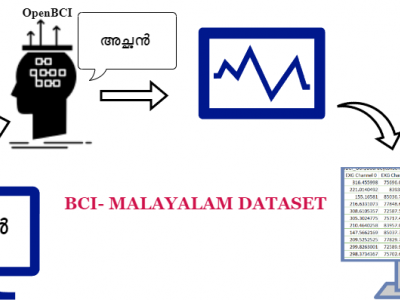Wearable Sensing

A specially designed waist-worn device with accelerometer, gyroscope, and pressure sensor was utilized to collect information about 18 ADLs and 16 fall types. The falls protocol has been performed in our lab to replicate realistic situations that typically affect workers and older people. In contrast to other datasets that are accessible to the public, we included a new task in the falls, syncope, since it has a high mortality rate among the elderly and is linked to falls. As such, we must take it into account and include it in our fall detection system.
- Categories:
 354 Views
354 ViewsIn today’s context, it is essential to develop technologies to help older patients with neurocognitive disorders communicate better with their caregivers. Research in Brain Computer Interface, especially in thought-to-text translation has been carried out in several languages like Chinese, Japanese and others. However, research of this nature has been hindered in India due to scarcity of datasets in vernacular languages, including Malayalam. Malayalam is a South Indian language, spoken primarily in the state of Kerala by bout 34 million people.
- Categories:
 929 Views
929 Views
While resistance training promotes muscle hypertrophy, accessibility of equipment is a barrier. This study evaluated a wearable VAriable Resistance Suit (VARS) as a novel and alternative method to achieve muscle hypertrophy. It was hypothesized that by providing adjustable, bi-directional and speed dependent resistance, VARS can target specific muscles to improve muscle strength, size and mass in an accessible and portable device.
- Categories:
 18 Views
18 Views
These are some graphs that record the human ocular electrical signals and ocular impedance signals, each image from top to bottom is a time-frequency graph of the EOG, the EOG signals, the time-frequency graph of the impedance signals, the impedance signals, and the impedance signals, respectively. This dataset is used to train the eye movement detection model.
- Categories:
 160 Views
160 Views
These are some graphs that record the human ocular electrical signals and ocular impedance signals, each image from top to bottom is a time-frequency graph of the EOG, the EOG signals, the time-frequency graph of the impedance signals, the impedance signals, and the impedance signals, respectively. This dataset is used to train the eye movement detection model.
- Categories:
 Views
ViewsAn understanding of local walking context plays an important role in the analysis of gait in humans and in the high level control systems of robotic prostheses. Laboratory analysis on its own can constrain the ability of researchers to properly assess clinical gait in patients and robotic prostheses to function well in many contexts, therefore study in diverse walking environments is warranted. A ground-truth understanding of the walking terrain is traditionally identified from simple visual data.
- Categories:
 306 Views
306 ViewsThe dataset contains data obtained by measuring hand movements while performing the letters of the Polish Sign Language alphabet. It contains data from 16 users performing all 36 letters ten times. Each single execution of a gesture is recorded in 75 samples. The experiment also included data augmentation, multiplying the number of data by 200. times.
- Categories:
 158 Views
158 ViewsWearable devices, such as data gloves and electronic skins, can perceive human hand's actions, behaviors and even emotions with the help of knowledge learning and inference. Curvature or magnetism sensing in such devices often lacks comprehensive gesture interactive information, meanwhile, the limited computing power of wearable applications restricts the multi-mode fusion of different sensing data and the deployment of deep learning networks.
- Categories:
 82 Views
82 Views
The dataset encompasses an extensive collection of patient information, delving into their comprehensive medical background, encompassing a myriad of features that encapsulate not only the physical but also the mental and emotional states. Furthermore, the dataset is enriched with invaluable ECG data derived from the patients. Moreover, our dataset boasts additional features meticulously extracted from the ECG records, thereby enhancing the potential for our machine learning model to undergo more effective training with our rich and diverse data.
- Categories:
 667 Views
667 ViewsWe define personal risk detection as the timely identification of when someone is in the midst of a dangerous situation, for example, a health crisis or a car accident, events that may jeopardize a person’s physical integrity. We work under the hypothesis that a risk-prone situation produces sudden and significant deviations in standard physiological and behavioural user patterns. These changes can be captured by a group of sensors, such as the accelerometer, gyroscope, and heart rate.
- Categories:
 844 Views
844 Views



